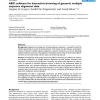27 search results - page 4 / 6 » Evolutionary Two-Dimensional DNA Sequence Alignment |
PSB
2004
14 years 7 days ago
2004
ct The preferential conservation of transcription factor binding sites implies that non-coding sequence data from related species will prove a powerful asset to motif discovery. We...
BMCBI
2004
13 years 10 months ago
2004
Background: Alignment and comparison of related genome sequences is a powerful method to identify regions likely to contain functional elements. Such analyses are data intensive, ...
BMCBI
2006
13 years 11 months ago
2006
Background: Evolutionary genomics requires management and filtering of large numbers of diverse genomic sequences for accurate analysis and inference on evolutionary processes of ...
BMCBI
2006
13 years 11 months ago
2006
Background: Molecular evolutionary studies of noncoding sequences rely on multiple alignments. Yet how multiple alignment accuracy varies across sequence types, tree topologies, d...
CIKM
2008
Springer
14 years 25 days ago
2008
Springer
Background: Accurate estimation of statistical significance of a pairwise alignment is an important problem in sequence comparison. Recently, a comparative study of pairwise stati...



